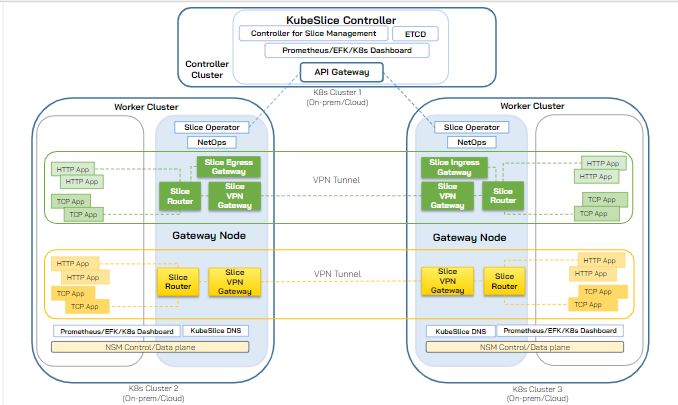High-Level Architecture
Introduction
KubeSlice is an open-source project that simplifies multi-cluster networking for multi-cloud, edge, cloud, hybrid-cloud, and bare-metal Kubernetes clusters. It is a vendor-neutral extensible framework to build flat overlay networks across heterogeneous Kubernetes clusters.
KubeSlice enables and simplifies pod-to-pod communications for L3-L7 protocols across a fleet of clusters by using a construct called Slice. Each slice can be associated with a set of clusters with varying topologies and can be associated with one or more namespaces in each cluster. The pods in the slice namespaces can reach each other over the slice-specific flat overlay network. It can also be described as an application-specific VPC that spans across clusters. KubeSlice allows creating multiple slices across clusters with each slice having a dedicated set of namespaces in each associated cluster. It enables easy segmentation and isolation of applications using slices. It allows namespace-sameness across the associated clusters in a slice. KubeSlice brings with it software-defined, highly-available and secure connections across clusters using VPN gateways.
KubeSlice can also be used to enable service discovery and reachability across clusters. KubeSlice enables service discovery across the slice using Service Exports and Imports in each cluster. A slice-associated namespace service running in a cluster can be exported over the slice overlay network so that it is discovered and reached by pods running in other clusters associated with the slice. SliceDNS in each cluster can be used for FQDN based inter-cluster service-service communications across the slice. Slice DNS has service entries with overlay network IP addresses for service endpoints.
The KubeSlice architecture consists of several components that interact with each other to manage the lifecycle of the slice overlay network. The diagram below shows the primary components of KubeSlice and the connections between them.

The controller cluster contains the KubeSlice Controller that manages user configuration and orchestrates the creation of the slice overlay network between multiple worker clusters. It defines and owns a number of CRDs that are used to store configuration and operational information in the cluster. The CRDs are also used in the interaction between the controller cluster and the worker clusters. The worker clusters connect to the Kubernetes API server of the controller cluster to fetch configuration that is stored in the custom resource objects.
The principal component of the worker clusters is the Slice Operator. It interacts with the controller cluster and sets up the needed infrastructure for the slice overlay network on the worker cluster. The Slice Operator provisions the gateways and setup routing rules to funnel traffic between the application pods and the gateway pods.




